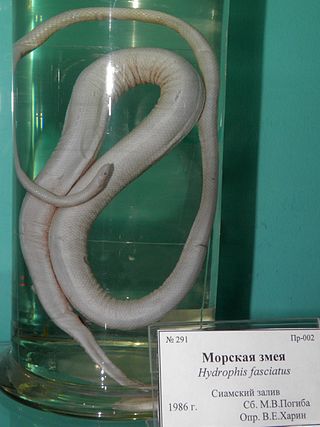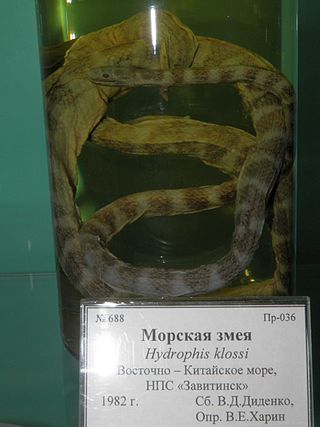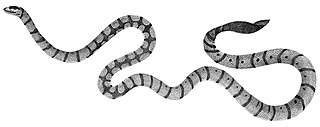
Elapidae is a family of snakes characterized by their permanently erect fangs at the front of the mouth. Most elapids are venomous, with the exception of the genus Emydocephalus. Many members of this family exhibit a threat display of rearing upwards while spreading out a neck flap. Elapids are endemic to tropical and subtropical regions around the world, with terrestrial forms in Asia, Australia, Africa, and the Americas and marine forms in the Pacific and Indian Oceans. Members of the family have a wide range of sizes, from the 18 cm (7.1 in) white-lipped snake to the 5.85 m king cobra. Most species have neurotoxic venom that is channeled by their hollow fangs, and some may contain other toxic components in varying proportions. The family includes 55 genera with around 360 species and over 170 subspecies.

Stokes's sea snake is a large species of sea snake in the family Elapidae. It is sometimes placed in its own genus Astrotia. The species is endemic to tropical Indo-Pacific oceanic waters.

Hydrophis belcheri, commonly known as the faint-banded sea snake or Belcher's sea snake, is an extremely venomous species of sea snake. It has a timid temperament and would normally have to be subjected to severe mistreatment before biting. Usually those bitten are fishermen handling nets, although only one-quarter of those bitten are envenomated since the snake rarely injects much of its venom. Although not much is known about the venom of this species, its LD50 toxicity in mice has been determined to be 0.24 mg/kg when delivered intramuscularly.

Hydrophis caerulescens, commonly known as the dwarf sea snake, is a species of venomous sea snake in the family Elapidae.

Hydrophis fasciatus, commonly known as the striped sea snake, is a species of venomous sea snake in the family Elapidae (Hydrophiinae).

Hydrophis klossi, commonly known as Kloss's sea snake, is a species of sea snake in the family Elapidae. Like all other sea snakes, it is venomous. The species is endemic to the Indian Ocean.
Hydrophis mamillaris, sometimes referred to as the Bombay sea snake or broad-banded sea snake is a species of venomous sea snake native to the Indian Ocean. It is a poorly studied and surveyed species, with few records and a dubious type specimen.

Hydrophis melanocephalus, commonly known as the slender-necked sea snake, is a species of venomous sea snake in the family Elapidae.

Hydrophis spiralis, commonly known as the yellow sea snake, is a species of venomous sea snake in the family Elapidae.
Hydrophis stricticollis, commonly called the collared sea snake, is a species of venomous sea snake in the family Elapidae.

Hydrophis curtus, also known as Shaw's Sea Snake, short sea snake, but often includes Hydrophis hardwickii is a species of sea snake. Like most Hydrophiinae sea snakes, it is a viviparous, fully marine, and front fanged elapid that is highly venomous. It is collected for a variety of purposes including human and animal food, for medicinal purposes and for their skin.

Microcephalophis gracilis, also known as the graceful small-headed seasnake, slender sea snake, narrow-headed sea snake, common small-headed sea snake, is a species of sea snake found in the Indian and Pacific Oceans. It is venomous.
Hydrophis viperinus, commonly known as the viperine sea snake, is a species of venomous sea snake in the family Elapidae (Hydrophiinae).

Sea snakes, or coral reef snakes, are elapid snakes that inhabit marine environments for most or all of their lives. They belong to two subfamilies, Hydrophiinae and Laticaudinae. Hydrophiinae also includes Australasian terrestrial snakes, whereas Laticaudinae only includes the sea kraits (Laticauda), of which three species are found exclusively in freshwater. If these three freshwater species are excluded, there are 69 species of sea snakes divided among seven genera.
Hydrophis semperi, commonly known as the Lake Taal snake, Garman's sea snake, the Philippine freshwater sea snake, and the Luzon sea snake, is a rare species of venomous sea snake found only in a single lake on the island of Luzon in the Philippines. It is noted for being one of two known species of sea snakes that are known to be found almost-exclusively in freshwater. The other freshwater sea snake species is Laticauda crockeri.

The yellow-bellied sea snake is a venomous species of snake from the subfamily Hydrophiinae found in tropical oceanic waters around the world except for the Atlantic Ocean. For many years, it was placed in the monotypic genus Pelamis, but recent molecular evidence indicates it lies within the genus Hydrophis.
Hydrophis donaldi, or the rough-scaled sea snake is a unique species of sea snake from Australia's Gulf of Carpentaria first described in 2012. It is a yellow to brown, striped snake that reaches up to a meter in length. It gives live birth and is venomous enough to be dangerous to humans. The primary distinguishing trait of the rough-scaled sea snake is the presence of a single spine on every scale covering the snake's body. The snake's tough, spiny scales may protect it from being buffeted against the rocks of its stony estuary habitats by the action of the waves and currents. Other less spectacular traits distinguishing it from other members of the genus Hydrophis include the lack of a groove running through the scales underlying its abdomen, a larger and rounder skull, differing numbers of scales around the circumference of different bodily regions, and a larger number of stripes than many sea snakes have.
Hydrophis torquatus, also known as the west coast black-headed sea snake, is a species of venomous sea snake in the family Elapidae that is native to Southeast Asia. The specific epithet torquatus (“collared”) refers to the body markings.










